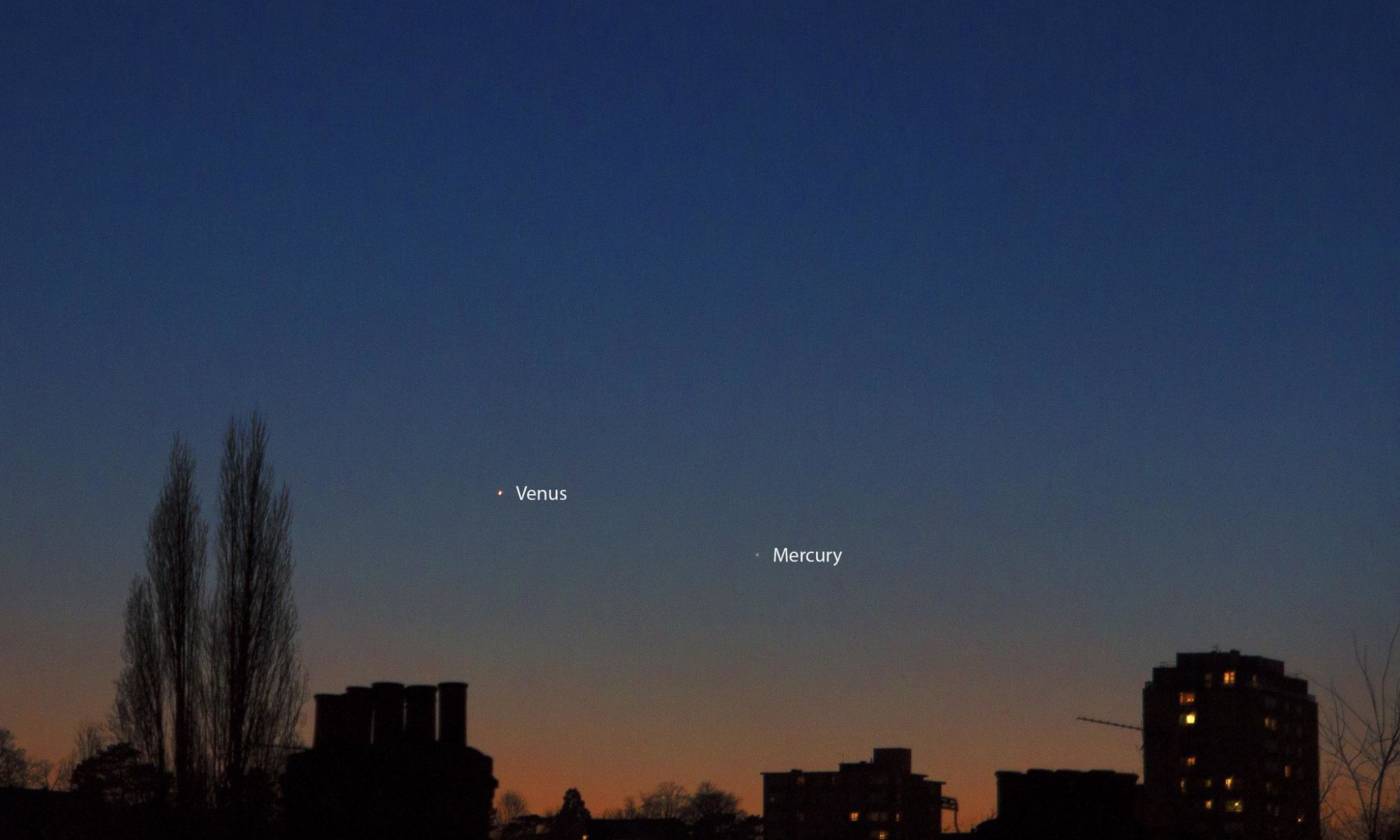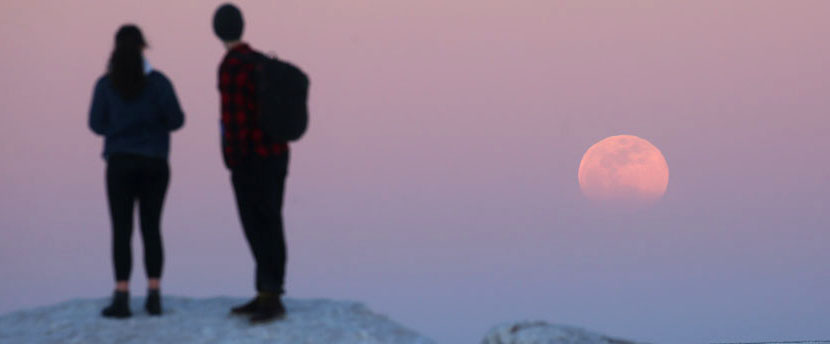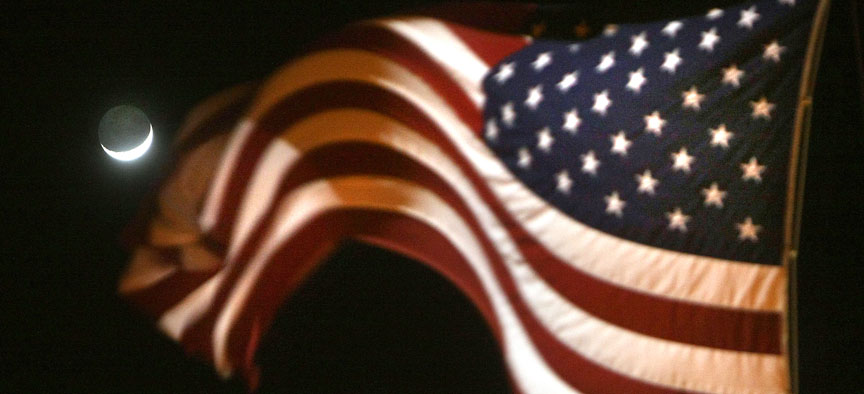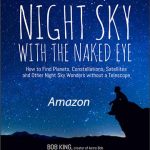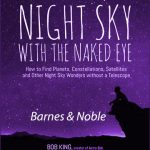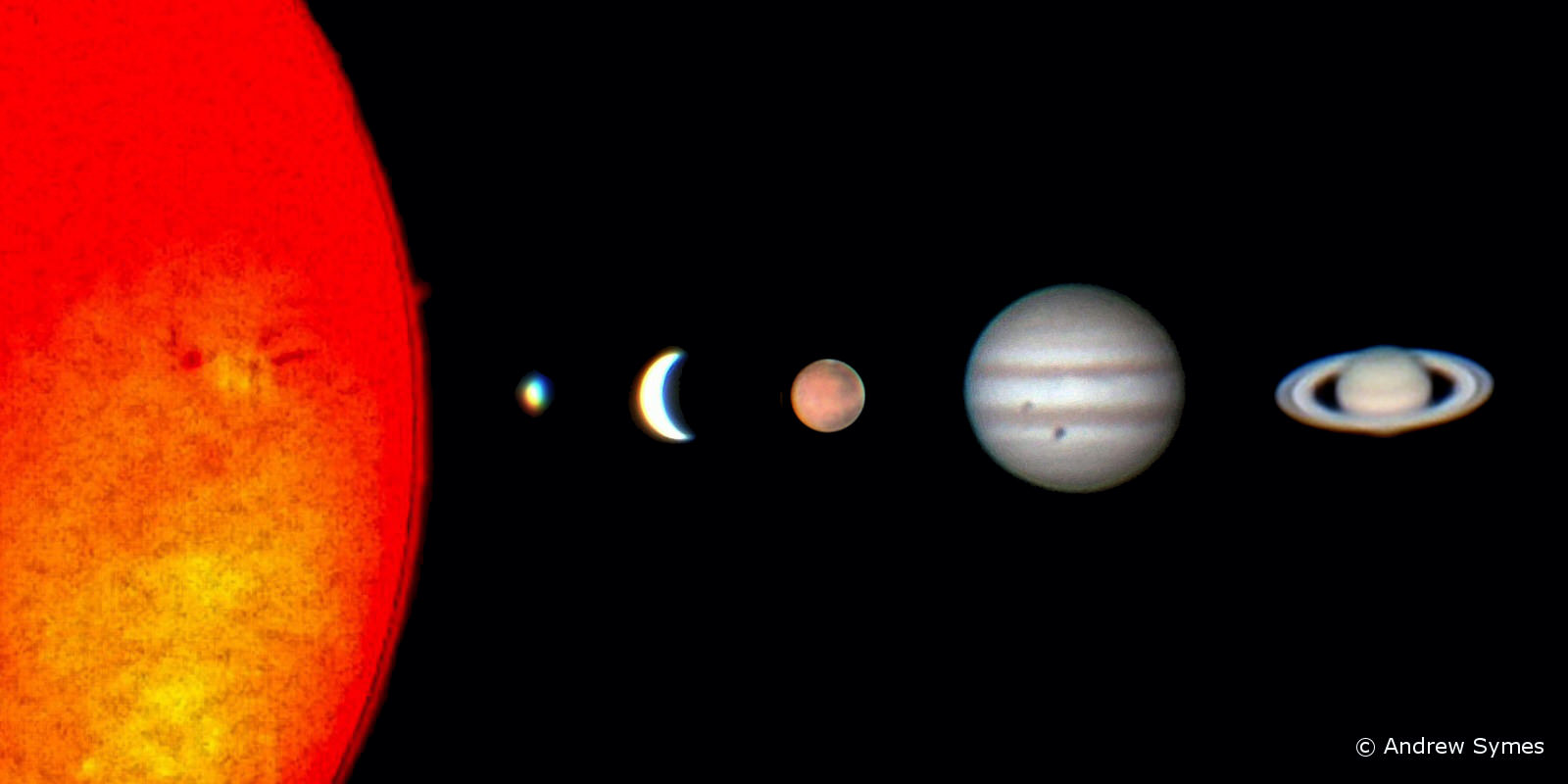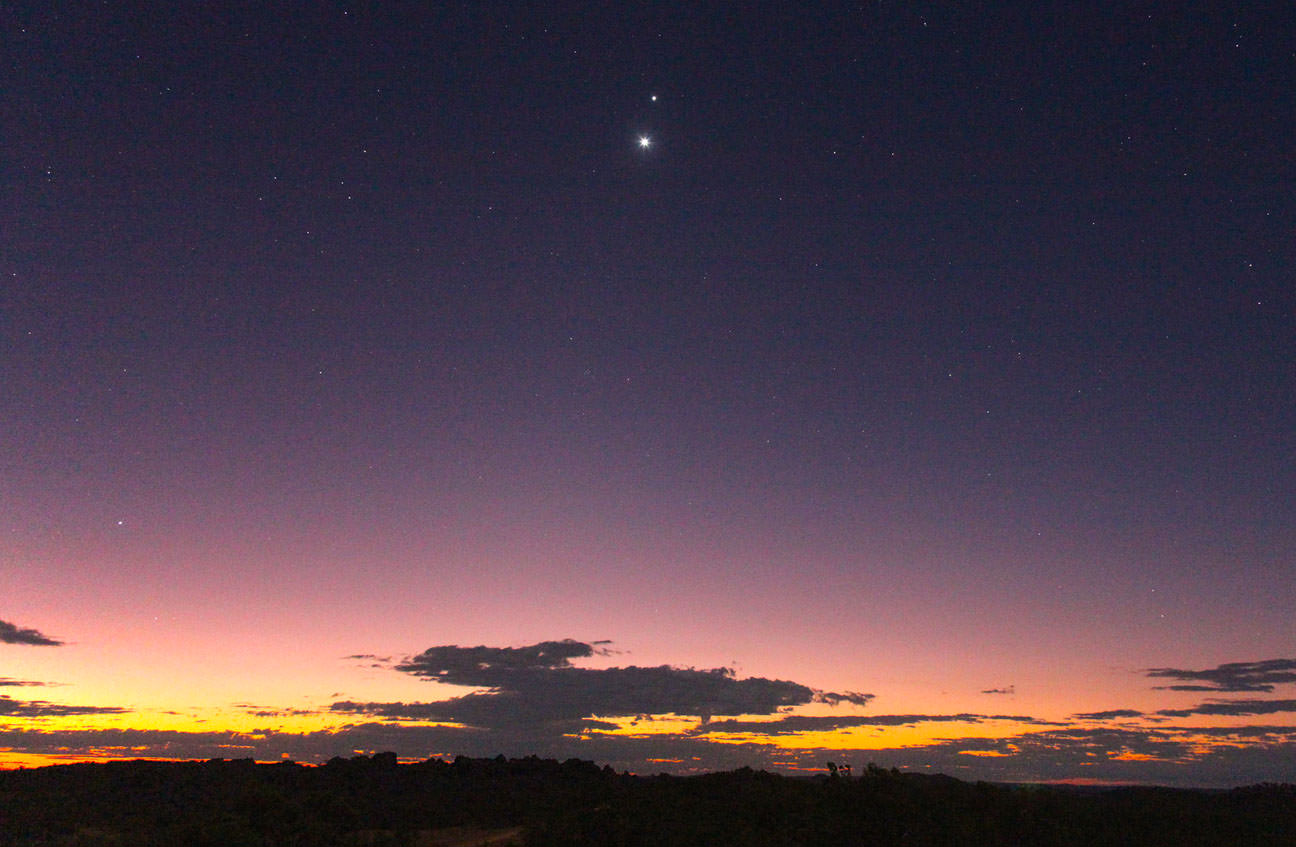What’s that? You say you’ve never seen elusive Mercury for yourself? You won’t have an excuse after this weekend, when the innermost world meets brilliant Venus at dusk in what is known as a planetary conjunction, one of the best for 2020.
Continue reading “Venus Meets Mercury This Weekend in a Fine Dusk Conjunction”Tiangong 1 Falls, Blue Moon Rises and Mars Takes Aim At Saturn

I apologize for the end-of-the-world title, but everything in it is true. And the world will still be here after it’s all done. On Friday (March 31) at 7:36 a.m. Central Time, the Moon will be full for the second time this month, which makes it a Blue Moon according to popular usage. Enjoy it. What with January’s Blue Moon and now this, we’ve chewed through all our Blue Moons till Halloween 2020.
I look forward to every full moon. Watching a moonrise, we get to see all manner of amazing atmospheric distortions play across the squat, orange disk. Once the sky’s dark, its outpouring of light makes walking at night a pleasure.
When a full moon occurs in spring, it hurries south down the ecliptic, the imaginary circle in the sky defining Earth’s orbit around the Sun. For northern hemisphere skywatchers, this southward sprint delays its rising by more an hour each night, forcing a quick departure from the evening sky. And that means blessed darkness for hunting down favorite galaxies and star clusters.
Tiangong 1 and a reentry simulation
As the Moon rolls along, the hapless Chinese space station Tiangong 1 hurtles toward Earth. Drag caused by friction with the upper atmosphere continues to shrink the spacecraft’s orbit, bringing it closer and closer to inevitable breakup and incineration. Since the Chinese National Space Administration (CNSA) lost touch with Tiangong 1 in March 2016, mission control can no longer power thrusters to de-orbit it at chosen time over a safe location like the ocean. The 9.3-ton (8,500 kg) station will burn up somewhere anywhere over a vast swath of the planet between latitudes 43°N and 43°S. Included within this zone are the southern half of Europe, the southern two-thirds of the U.S., India, Australia and much of Africa and South America.
Not until the day of or even hours before will have a clear idea of when and where the station will meet its fate. According to the latest update from the Aerospace Corp., which monitors falling spacecraft, reentry is expected on Easter Sunday (April 1) at 10:30 UT / 5:30 a.m. Central Time plus or minus 16 hours. This morning (March 29), the space station is circling Earth at about 118 miles (190 km) altitude. The lowest a satelllite can still make a complete orbit of the planet is about 62 miles (100 km). Below that, break-up begins.
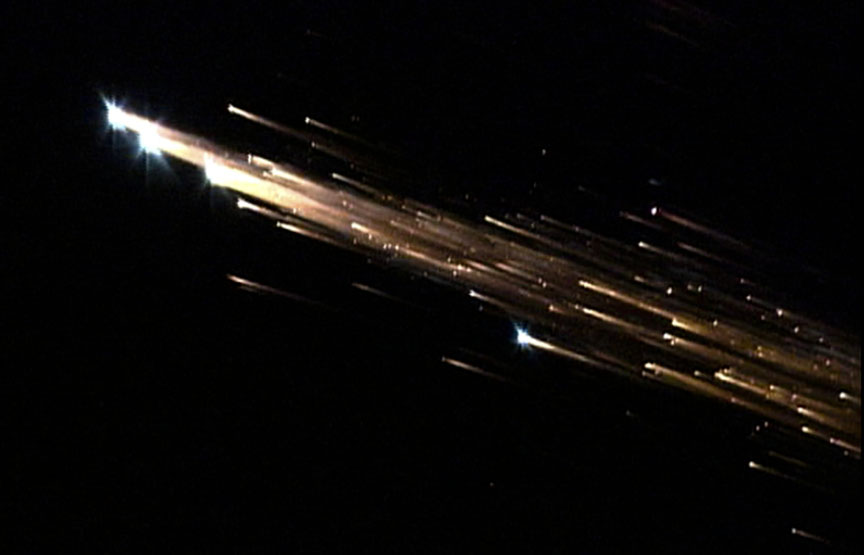
For up-to-the-minute updates on when to expect Tiangong 1’s orbit to decay and the machine to plunge to Earth, check out Joseph Remis’ Twitter page. Most of the space station is expected to burn up on reentry, but larger chunks might survive all the way to the ground. Since much more of the Earth’s surface is water these remnants will likely end up in the drink … but you never know. If Tiangong-1 does come down over a populated area, observers on the ground will witness a spectacular, manmade fireball day or night.

On the quieter side but nearly as eye-catching, Mars will overtake Saturn in the coming week, passing just 1° south of the ringed planet in a thrilling dawn conjunction on April 2. If the weather forecast doesn’t look promising that morning, the two planets will remain within 2° of each other now through April 6th, providing plenty of opportunities for a look.
You can easily tell them apart by color: Mars is distinctly red-orange and Saturn looks creamy white. Both are bright at around magnitude 0 though Mars is now a hair brighter by two-tenths of a magnitude. Will you be able to see the difference?
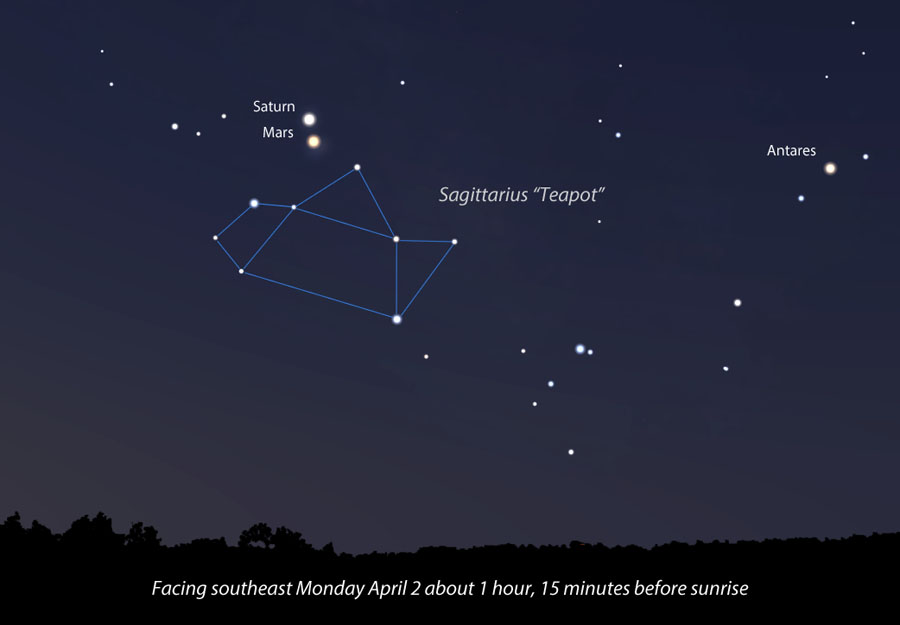
In most telescopes at low magnification both planets will comfortably fit in the same field of view. Saturn’s rings are tilted nearly wide open and quite beautiful. Mars appears gibbous and though still rather small, it’s brightening rapidly and drawing closer in time for its closest approach to Earth since 2003. Wishing you clear skies!
November Opens with a Splendid Gathering of Moon and Planets
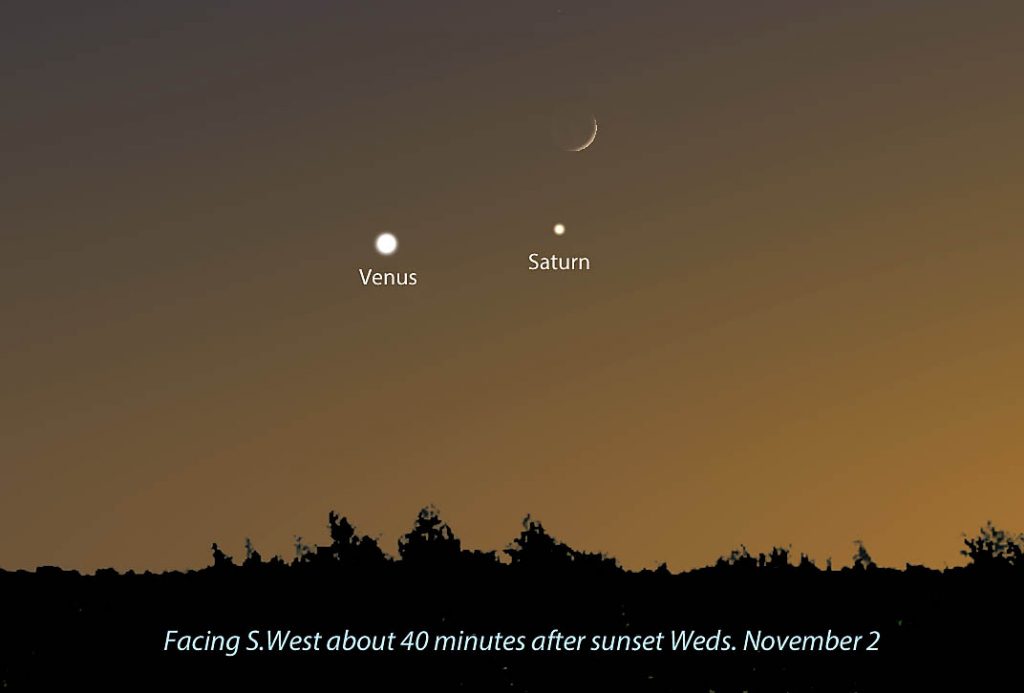
I love easy and bright. While I often spend time seeking faint nebulae and wandering comets, there’s nothing like just looking up and seeing a beautiful scene aglow in the night sky. No binoculars or telescope needed. That’s exactly what will happen Tuesday November 2, when an attractive crescent Moon will join Saturn and Venus at dusk in the southwestern sky.
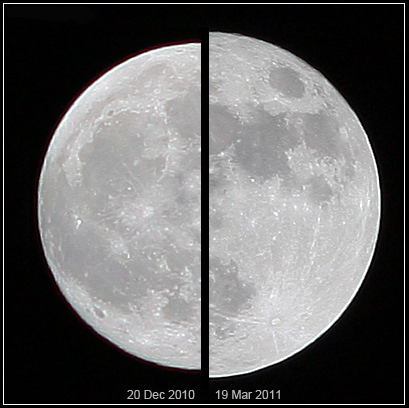
What a fine threesome they’ll make: Venus the white-hot spark shining at magnitude –4.0; Saturn a mellow magnitude +0.5, some 20 times fainter and the Moon a fingernail crescent above them both. The Moon will be just two days past apogee, the furthest point in its orbit from Earth. Does it look a little smaller than the usual crescent? If you’re a keen watcher of crescents, you just might notice the difference.
In less than two weeks, on November 14, the crescent will have waxed to full, swung around to the opposite end of its orbit, where it will be at perigee, its closest point to Earth. When a Full Moon occurs at perigee, we call it a Supermoon because it’s closer and correspondingly bigger and brighter than a typical Full Moon.
For a variety of reasons, the November Supermoon will come exceptionally close to Earth, the closest one in 70 years as a matter of fact. The last time Earth and Moon embraced each other so tightly was January 26, 1948, the year baseball great Babe Ruth died. But I’m getting ahead of myself. We’ll have much more on the Supermoon soon!
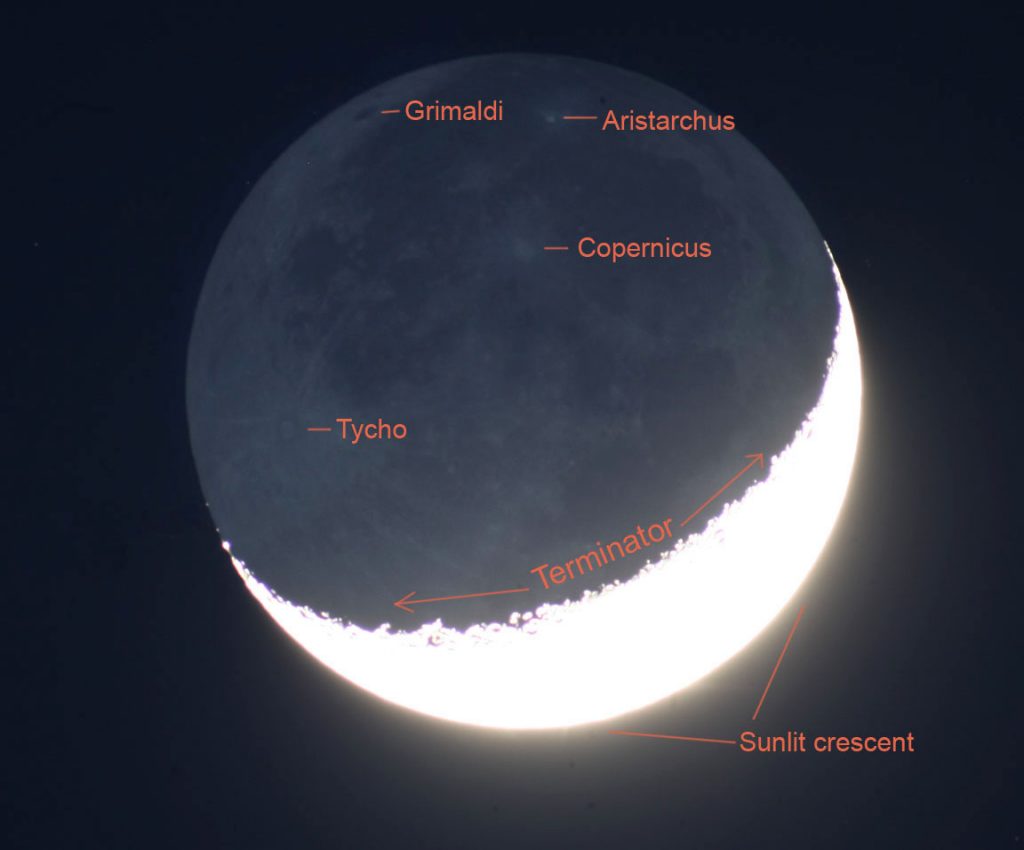
Tuesday night you have the pleasure of an eye-catching crescent filled with darkly luminous earthshine, sunlight reflected off our jolly blue and white globe into space that reflects from the Moon and back to Earth. Being twice reflected, the returning light is feeble, giving the Moon a haunted look.
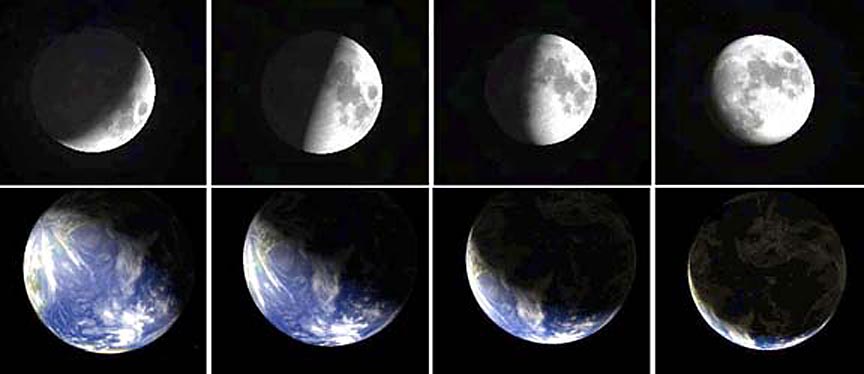
Crescent phase is when earthshine is brightest. Why? Phases of Earth and Moon are complementary — when we see a crescent, an astronaut on the Moon would look back to see a nearly Full Earth in the sky. As you’ve already guessed, a Full Earth reflects a great deal more light than a half or crescent. Be sure to point your binoculars at the earth-lit Moon; the contrast of dusky earthlight adjacent to the sunlit crescent gives the scene a striking 3D look.
And if your glass can magnify ten times or more, you’ll get a sneak preview of several of the dark lunar seas or maria in the smoky light. Seas that will by and by ease into sunlight as the lunar terminator, the line separating day from night, rolls ever westward.
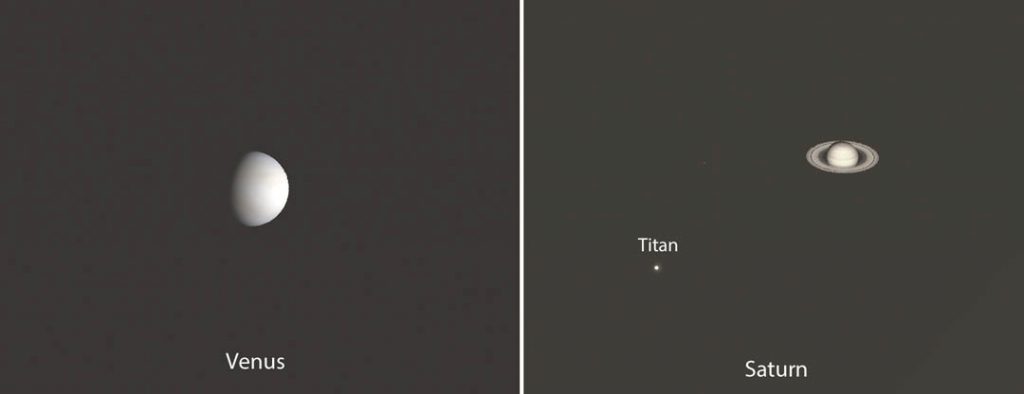
Have a small telescope? This may be one of your last easy chances at seeing the planet Saturn before it’s gobbled up by the western horizon. The ringed one has been sinking westward the past couple months and will soon be in conjunction with the Sun. I hate to see a good planet go, that’s why I’m happy to share that Venus will be with us a long, long time. Watch for this most brilliant of planets to rise higher in the southwestern sky as we approach Christmas and then swing to the north through early winter before dropping out of the evening sky in March 2017.
Thank you Venus for lighting our path on the snowy nights that lie ahead!
*** If you’d like learn more about how to find the planets, check out my new book, Night Sky with the Naked Eye. It covers all the wonderful things you can see in the night sky without special equipment. The book publishes on Nov. 8, but you can pre-order it right now at these online stores. Just click an icon to go to the site of your choice – Amazon, Barnes & Noble or Indiebound. It’s currently available at the first two outlets for a very nice discount:
5 Days, 2 Spectacular Conjunctions
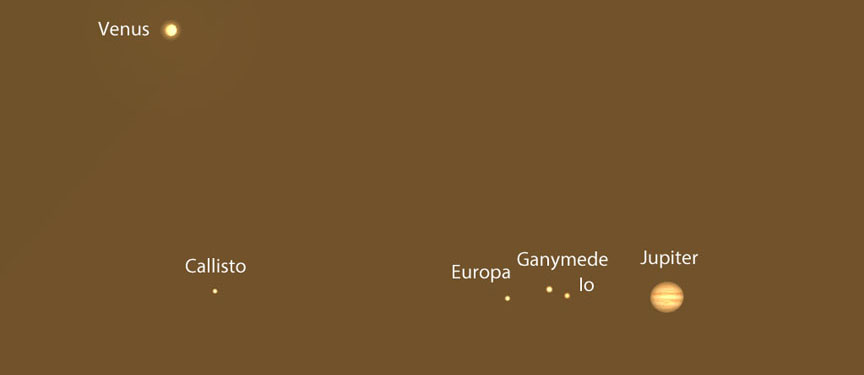

Conjunctions of bright planets make for jewelry in the sky. This week, get ready for some celestial shimmer. If you’ve been following the hither and thither of Mars and Saturn near Antares this summer, you know these planets have been constantly on the move, creating all kinds of cool alignments in the southern sky.
On Tuesday night (August 23) the hopscotching duo will fall in line atop Antares in the southwestern sky at nightfall. Mars will sit just 1.5° above the star and Saturn 4° above Mars. Viewed from the Americas and Europe, the line will appear slightly bent. To catch them perfectly lined up, you’ll have to be in central Asia on the following evening, but the view should be pleasing no matter where you live.
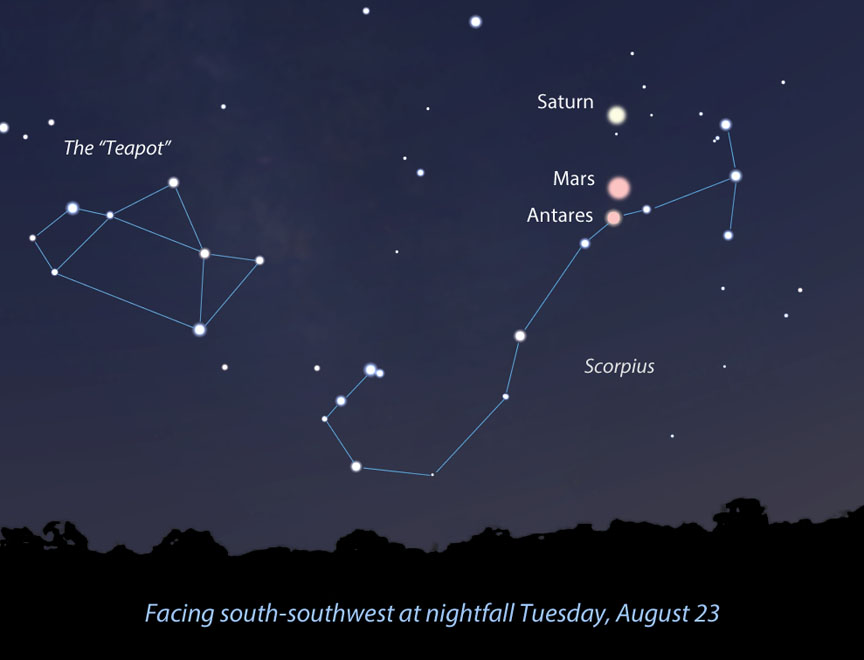
Nice as it is, the Mars-Saturn-Antares lineup is only the warm-up for the big event: the closest conjunction of the two brightest planets this year. On Saturday evening, August 27, Venus and Jupiter will approach within a hair’s breadth of each other as viewed with the naked eye — only 0.1° will separate the two gems. That’s one-fifth of a full moon’s width! While Mars and Saturn will be a snap to spot low in the southwestern sky during their conjunction, Venus and Jupiter snuggle near the western horizon at dusk.
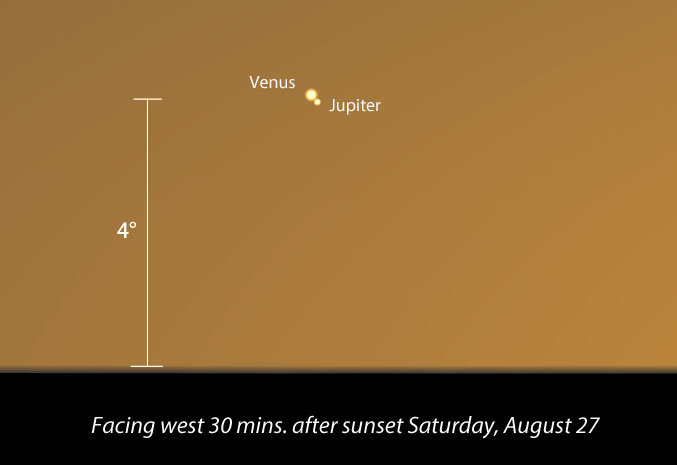
To make sure you see them, find a place in advance of the date with a wide open view to the west. I also suggest bringing a pair of binoculars. It’s so much easier to find an object in bright twilight with help from the glass. You can start looking about 25 minutes after sunset; Venus will catch your eye first. Once you’ve found it, look a smidge to its lower right for Jupiter. If you’re using binoculars, lower them to see how remarkably close the two planets appear using nothing but your eyeballs. Perhaps they’ll remind you of a bright double star in a telescope or even the twin suns of Tatooine in Star Wars.
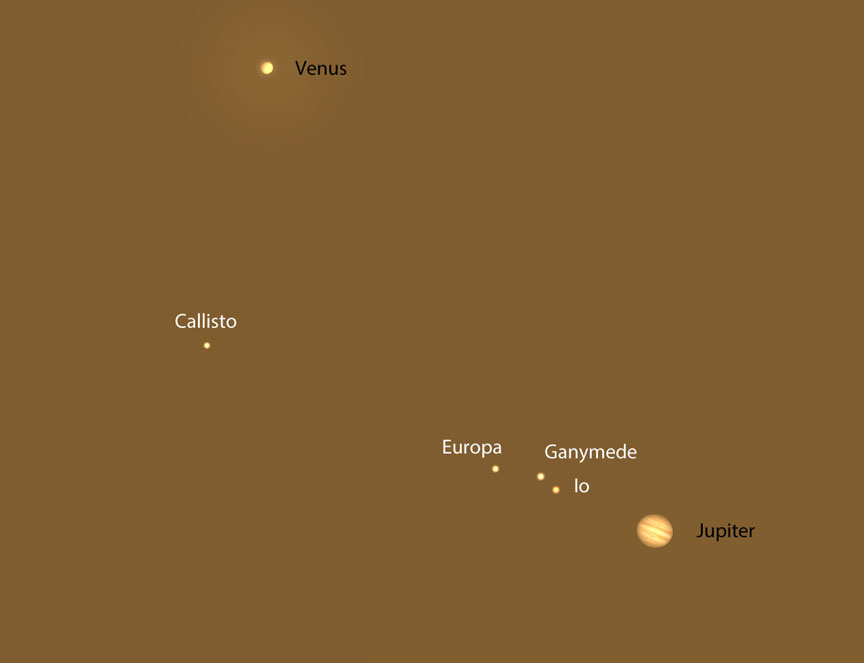
Have a small telescope? Take it along — Jupiter and Venus are so close together that they easily fit in the same high magnification field of view. Jupiter’s four brightest moons will be on display, and Venus will look just like a miniature version of the waxing gibbous moon. Rarely do the sky’s two brightest planets nearly fuse, making this a not-to-miss event.
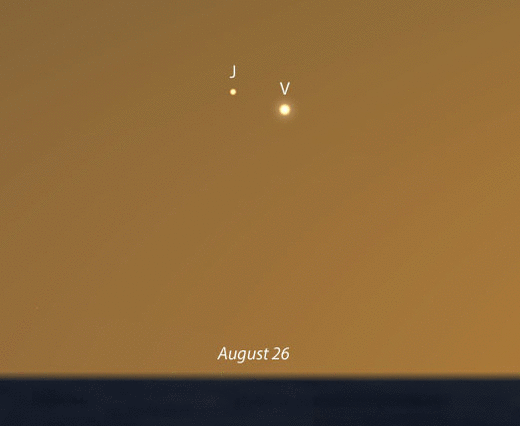
If cloudy weather’s in the forecast that night, you can still spot them relatively close together the night before and night after, when they’ll be about 1° or two full moon diameters apart. I get pretty jazzed when bright objects approach closely in the sky, and I’m betting you do, too.
I also don’t mind being taken in by illusion once in a while. During a conjunction, planets only appear close together because we view them along the same line of sight. Their real distances add a dose of reality.
On Saturday evening Venus will be 143 million miles (230 million km) away vs. 592 million miles (953 million km) for Jupiter. In spite of appearing to almost touch, Jupiter is more than four times farther than the goddess planet.

That distance translates to the chill realm of the giant gaseous planets where sunlight is weak and ice is common. Try stretching your imagination that evening to sense as best you can the vast gulf between the two worlds.
You might also try taking a picture of them with your mobile phone. I suggest this because the sky will be light enough to get a hand-held photo of the scene. Photos or not, don’t miss what the planets have in store for earthlings this week.
See All Five Naked Eye Planets in the Dusk Sky at Once
Hosting an evening star party this summer? You’re in for a treat. Starting later this week, all five naked eye planets (Mercury, Venus, Mars, Jupiter and Saturn) are visible in the evening sky at dusk for a brief few weeks. We had a similar lineup in the dawn sky earlier in 2016, as the Earth had all the inner planets in its forward-facing view — now, we see these same planets in our collective rear view mirror, as we lap Mars, Jupiter and Saturn on the inner track, while Mercury and Venus race to catch up with us.
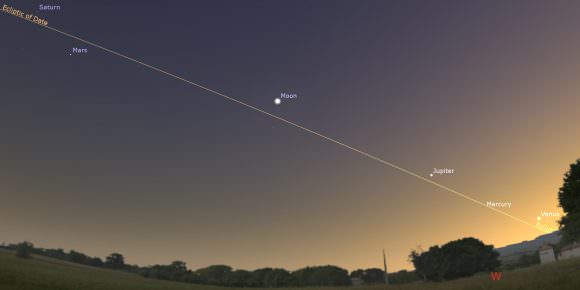
At their narrowest, the planets from Saturn to Mercury fit within a span just 75 degrees wide in the last half of August. A wide field all-sky shot should catch ’em all in the same frame at once. This isn’t a ‘grand conjunction’ in a strict sense. To have all five planets visible, you need the slowest and outermost of the five — Jupiter and Saturn, with orbital periods of 11.9 and 29.5 years respectively — in the same general swath of sky. Both are headed towards conjunction on December 21st, 2020, making such groupings more frequent as they race past the other three. The next true quintuple grand conjunction occurs on September 8th, 2040, when all 5 planets span just 9.3 degrees of the sky… the closest span since September 18th, 1186!
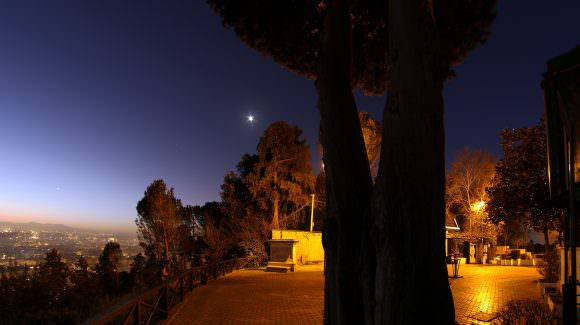
There’s a lot to watch out for in the next few weeks. Here’s a who’s who of planets this July and August, from east to west:
Saturn: shining at magnitude +0.4 in the constellation Ophiuchus, Saturn is fresh off of opposition on June 3rd. Riding high in the southeast at dawn, Saturn makes a close 4.4 degree pass near Mars on August 24th, and the pair makes a straight line completed by the bright star Antares on the same date.
Mars: High to the south in the constellation Libra at dusk, Mars begins its slow dive into the dusk during the last half of 2016. Currently shining at a respectable magnitude -0.9, Mars passed opposition on May 22nd and is headed towards a grand opposition in 2018, nearly as close as the historic close pass of 2003.
Jupiter: Sitting in the constellation Leo, Jupiter shines at magnitude -1.6 and is about 20-30 degrees above the southwestern horizon at dusk. Jupiter passed quadrature 90 degrees east of the Sun on June 4th and opposition for 2016 on March 8th.
Venus: The bashful planet of the group, Venus is slowly appearing from behind the Sun low in the dusk and headed for a brilliant dusk apparition later in 2016 and early 2017. Currently 3 degrees east of the Sun on July 31st, Venus reaches greatest elongation 47 degrees east of the Sun on January 12th, 2017. We’ve just been able to begin spying Venus using binocs last week from the rooftop of our Casablanca Air BnB. Follow that planet, as Venus makes a close 6′ pass near Jupiter on August 27th.
Mercury: And the innermost planet makes five, as Mercury reaches greatest elongation 27 degrees east of the Sun on August 16th. When can you first catch sight of Mercury, completing the fivesome? Jupiter and Venus actually make great bookends in the hunt, as +0.5 magnitude Mercury wanders between them through early August. It’s too bad dusk twilight obscured the view this past weekend, as both Mercury and Venus photobombed the Beehive Cluster M44 in Cancer. Mercury also passes 20′ from the bright star Regulus on July 30th.
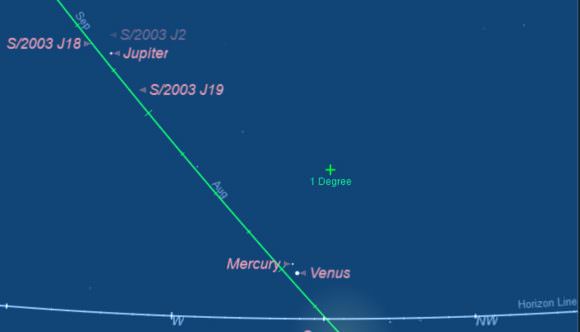
But wait, there’s more. The Moon passes New on August 2nd, entering back into the dusk sky. The one day old Moon will pass the grouping of Venus, Regulus and Mercury on the evening of August 4th, actually occulting (passing in front of) Mercury for the southernmost tip of South America. The Moon then moves on to occult Jupiter for good measure on August 6th for the South Pacific and southeast Asia in the daytime. Finally, the waxing gibbous Moon makes a wide pass near Mars, Antares and Saturn on the evening of August 12th, on the same evening that the 2016 Perseids are due to occur.
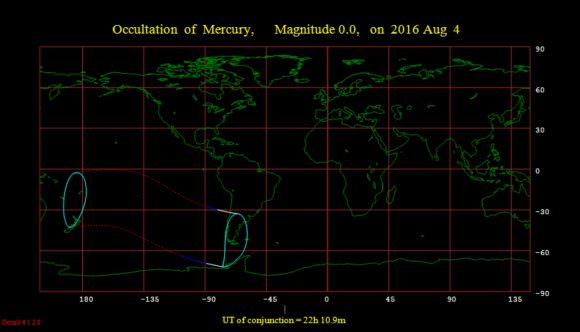
The Moon also reaches the nearest apogee (think ‘closest far point’) of the year, at 404,265 kilometers from the Earth on August 10th and reaches Full on August 18th, featuring a subtle penumbral eclipse and the start of eclipse season 2 of 2 for 2016.
More on all of these events in the coming weeks. So, if you find yourself out hunting Pokémon G0 creatures ’til the late dusk hours this summer, don’t forget to look up at the greatest show in the solar system!
Stunning Conjunction of Mars and Beta Scorpii This Week
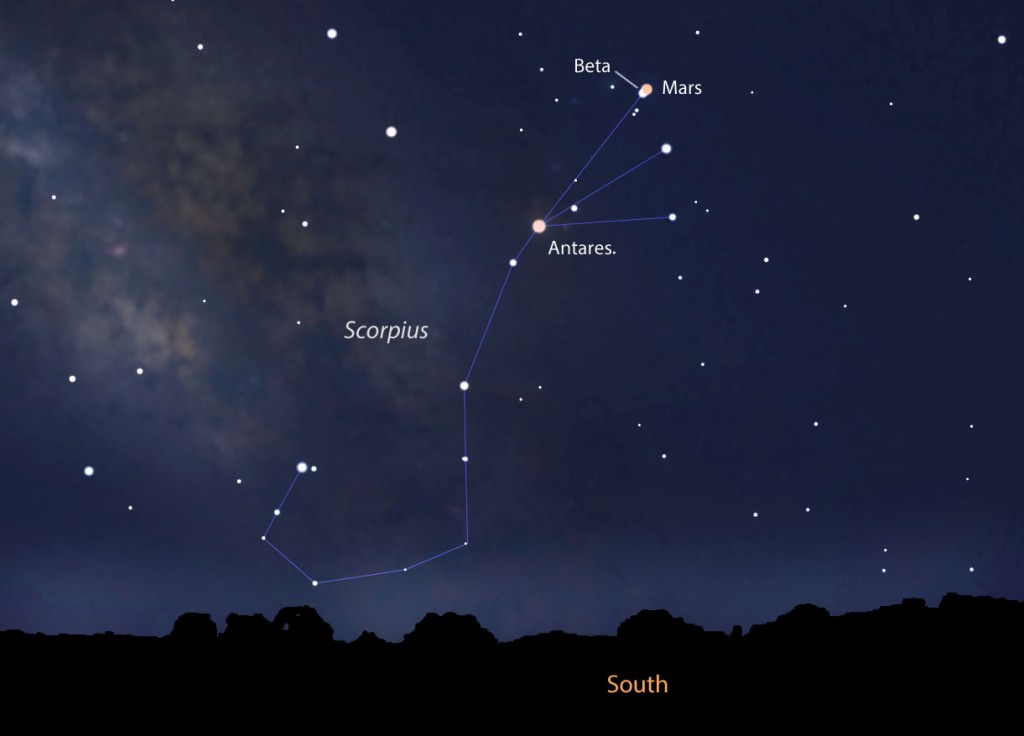
Planets can sneak up on you. Especially the ones that don’t rise till you’re in bed. Take Mars for instance. It’s been ambling east along the morning zodiac all winter long; today it enters Scorpius, rising around 1:30 a.m. Not two days later, the planet will have a spectacularly close conjunction with Beta Scorpii, the topmost star in the scorpion’s head.
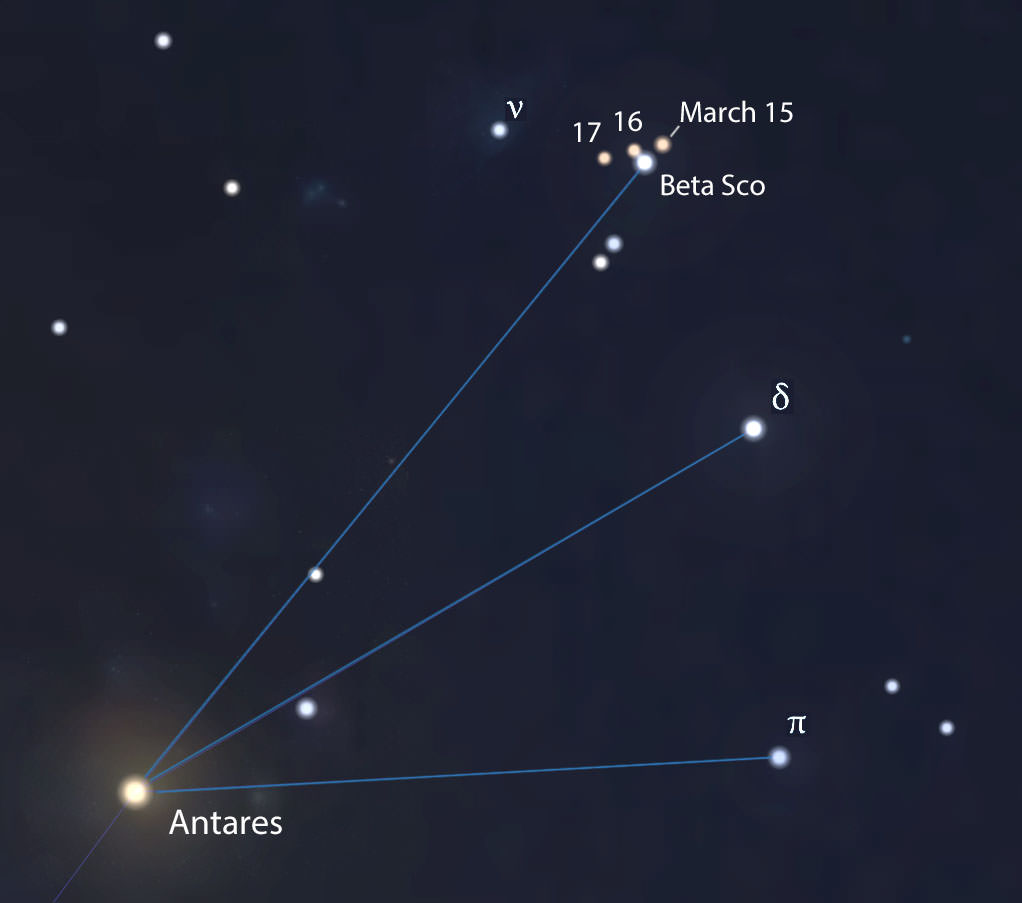
Also known as Graffias, Beta shines at magnitude +2.6 next to the fiery, zero-magnitude Mars. With their striking color contrast, the two would make a superb ring setting: a tiny diamond nestled next to a plump garnet. They’ll be together for several mornings, their separation changing each day: 15 arc minutes on Tuesday (1/2 the diameter of the Full Moon); 9 arc minutes when closest on Wednesday and back out to 23 minutes on Thursday.
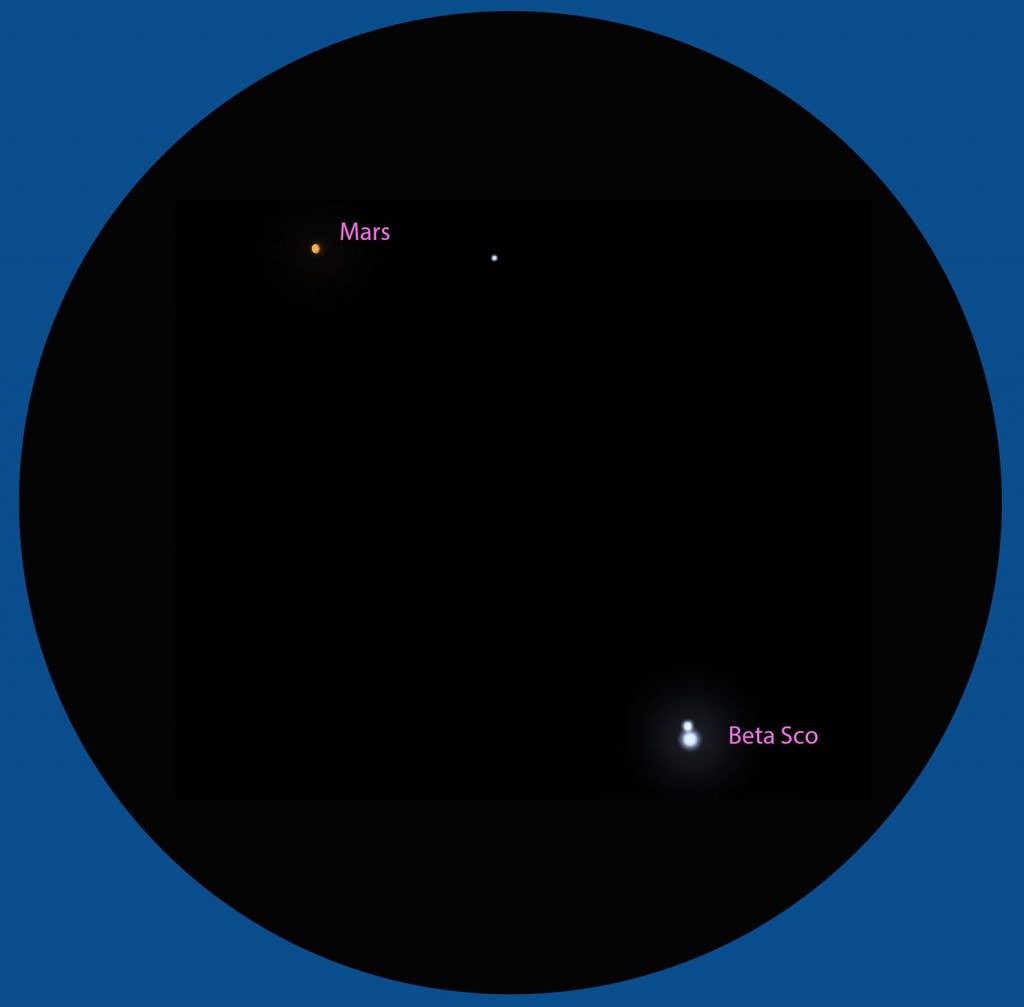
It’s a gas to see two celestial objects approach so closely, but this conjunction offers a rare treat. Did you know that Beta is one of the finest double stars in the sky? It has a fifth magnitude companion 14 arc seconds northeast of the primary. Any telescope will split this jewel and show Mars in the same field of view at both high and low magnifications. That’s just so cool — I sure hope you’ll get to see them.
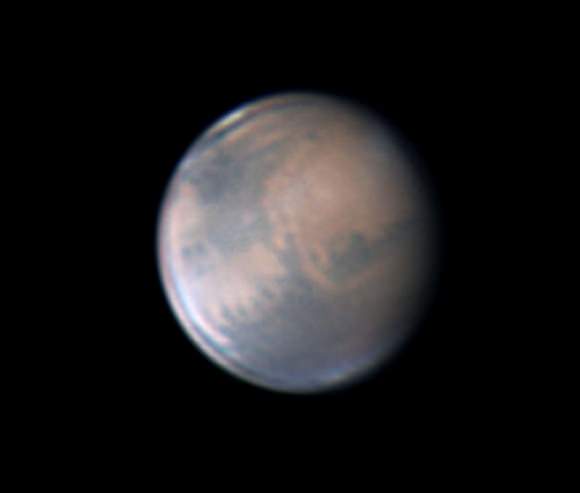
Mars now measures 10 arc seconds in diameter, small for sure, but big enough to see the larger dark markings and a hint of the north polar cap. The planet is heading for opposition on May 22nd, when it will shine at magnitude -2.0 (brighter than Sirius) with a disk 18.4 arc seconds across, its biggest and closest since 2005.
Let this week’s lovely conjunction serve as a warm-up to the forthcoming season of Mars.
Guide to October’s Conjunction Mania, See Venus in Daylight

Tomorrow morning might be a good time to call for extra celestial traffic control. A slip of a crescent Moon will join a passel of planets in the dawn sky for the first of several exciting conjunctions over the next few days.
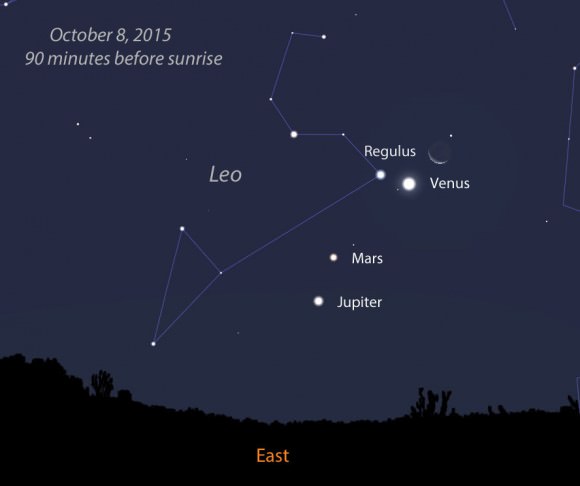
In the space of three mornings beginning tomorrow, four planets, the Moon and the star Regulus will participate in six separate conjunctions. Here’s how it’ll play out. Time are shown in UT / Greenwich Mean Time and Central Daylight and 1° equals two full moon diameters:
- October 8: Venus 2.5° south of Regulus at 18 UT (1 p.m. CDT)
- October 8: Regulus 3.1° north of the moon at 19 UT (2 p.m. CDT)
- October 8: Venus 0.6° north of the moon at 20 UT (3 p.m. CDT)
- October 9: Mars 3.2° north of the moon at 14 UT (9 a.m. CDT)
- October 9: Jupiter 2.5° north of the moon at 21 UT (4 p.m.)
- October 11: Mercury 0.8° north of the moon 11 UT (6 a.m. CDT)
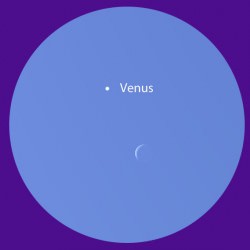
Since several of the events occur in the middle of the afternoon for skywatchers in the Americas, here’s an expanded viewing guide:
* Thursday, October 8: Skywatchers will see Venus pass 2.5° south of Leo’s brightest star Regulus with a cool crescent moon a little more than 3° to the west of the brilliant planet. If you live in Japan and the Far East, you’ll see a splendidly close conjunction of the moon and Venus at dawn on October 9, when the pair will be separated by a hair more than one moon diameter (0.6°). At nearly the same time, the moon will be in conjunction with Regulus.
Observers in Australia and New Zealand will see the Moon occult Venus in a dark sky sky before dawn (or in daylight, depending on exact location) on the 9th. Click HERE for information, times and a map for the event.
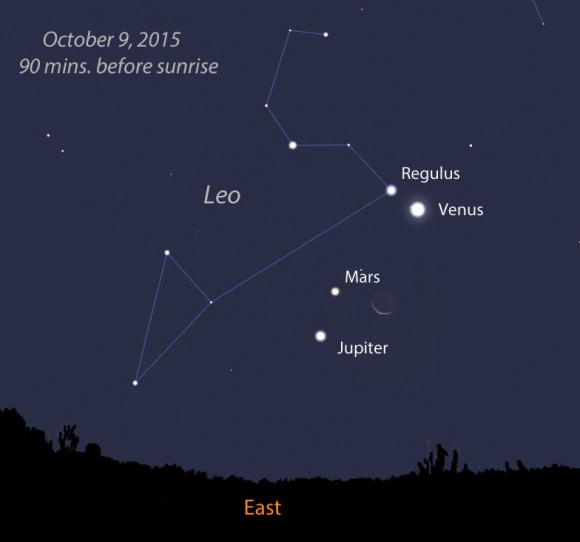
* Friday, October 9: An even thinner moon passes about 3° north of Mars in the Americas at dawn and approximately 4° from Jupiter. Watch for the three luminaries to sketch a nifty triangle in the eastern sky 90 minutes to an hour before sunrise. Venus will gaze down at the planetary conclave 10° further west.
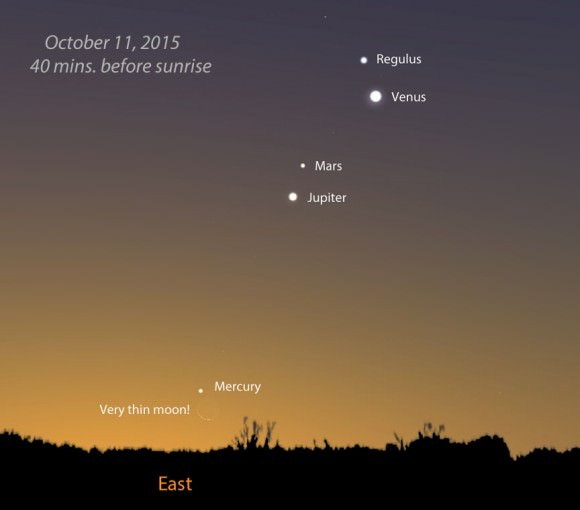
* Sunday, October 11: Mercury, which has quietly taken up residence again in the dawn sky, hovers 0.8° above a hair-thin moon this morning at 6 a.m. CDT. Best views will be about 45 minutes before sunrise, when the pair rises high enough to clear distant trees. Bring binoculars to help you spot the planet.
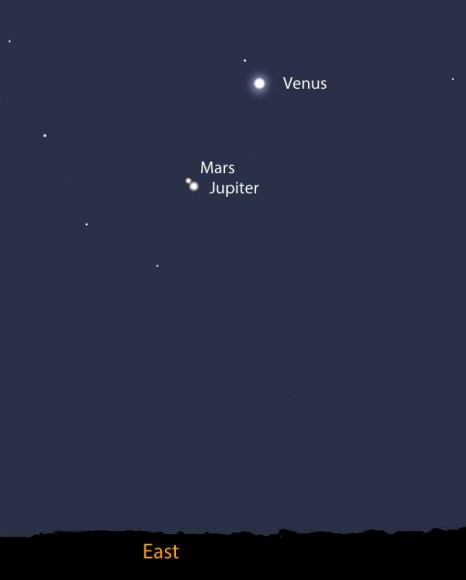
You’re thinking, why does this all have to happen in the morning? Thankfully, sunrise occurs around 7 a.m. for many locations, so you can see all these cool happenings in twilight around 6 a.m. — not terribly unreasonable. And now that the The Martian has finally hit the movie theaters, what better time to see the planet in the flesh? By pure coincidence, the location of stranded astronaut Mark Watney in the fictional account — Acidalia Planitia (Mare Acidalium) — will be facing dawn risers across the Americas and Hawaii this week.
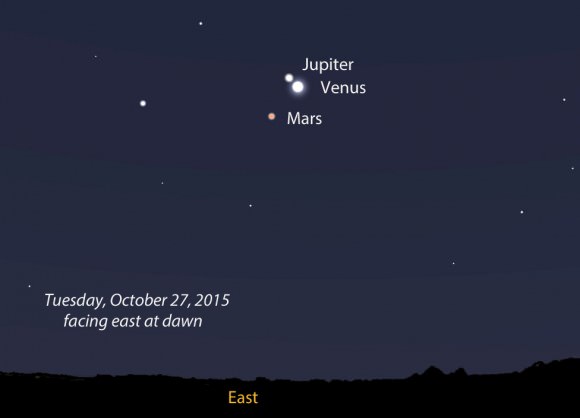
Dare I say this string of continuous conjunctions is only a warm-up for more to come? Earth’s revolution around the Sun quickly brings Jupiter higher in the eastern sky, while Mars races eastward as if on a collision course. The following Saturday on October 17, the two will meet in conjunction less than 1/2 degree (one Full Moon width) apart. Very nice!
But it gets even better. On Tuesday morning, October 27, you’ll see all three planets huddle at dawn. One degree will separate Jupiter and Venus with Mars bringing up the rear several degrees further east. Feast on the view because there won’t be a more compact arrangement of three planets again until January 10, 2021.
Mars Meets the King of the Beasts
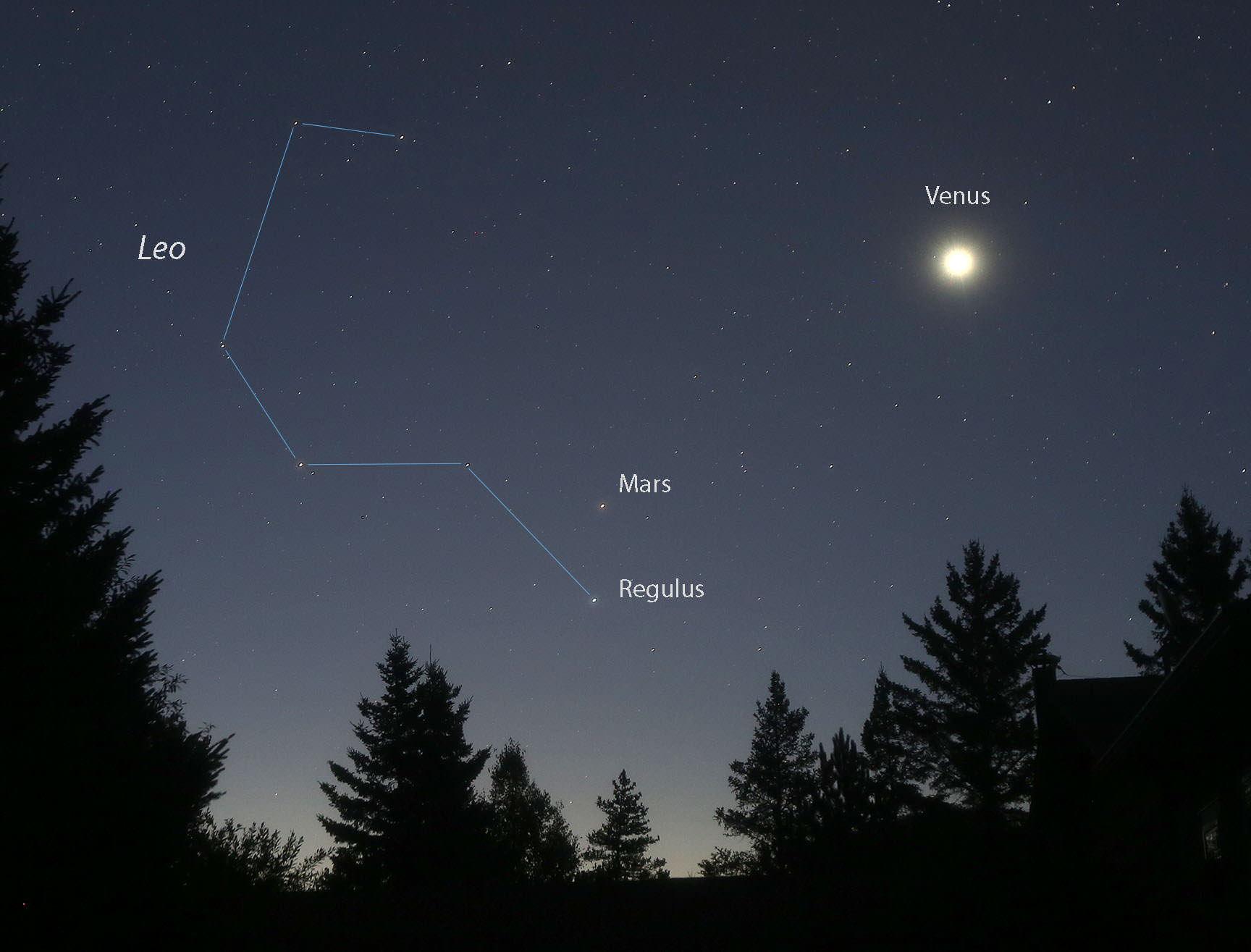
I was up before dawn today hoping to find the returning comet 205P/Giacobini and a faint new supernova in the galaxy IC 1776 in Pisces. I was fortunate to see them both. But the morning held a pleasant surprise I hadn’t anticipated. Venus rose brilliantly in the east followed by the much dimmer planet Mars some 10° to its lower left. And there, not more than a couple degrees below Mars, shone Leo’s brightest star, Regulus. At first glance both appeared about equally bright, but looking closer, it was clear that Regulus, at magnitude +1.3, bested Mars by nearly half a magnitude. What was especially appealing was the color contrast between the two with Mars’ dusty, rusty surface so different from the pure white radiance of Regulus.
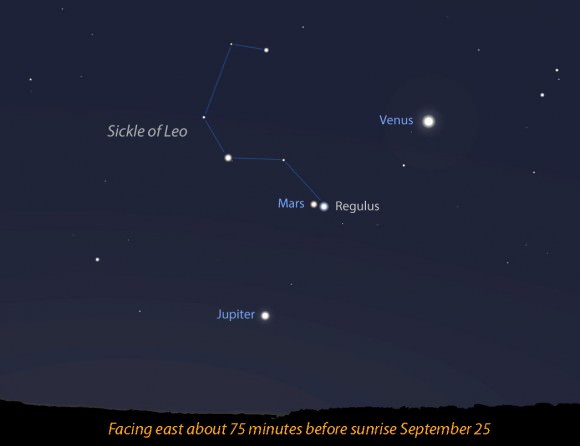
While star and planet are both close enough to catch the eye, they’re headed for an excellent conjunction Thursday and Friday mornings, September 24 and 25. The actual time of closest approach, when star and planet will be separated by just 0.8°, occurs around 11 p.m. CDT — before Mars rises for skywatchers in the Americas and Canada, but about perfect for European and African observers.
Just the same, everyone around the planet will see them less than a degree apart low in the eastern sky about 90 minutes to an hour before sunrise on those dates. Joining the scene will be Venus, now spectacularly bright against the deep blue, early dawn, and Jupiter, bringing up the rear further lower down in Leo’s tail.
Regulus is a main sequence star like the Sun but hotter. It spins so fast that it’s stretched into an oblate spheroid 4.3 times the diameter of the Sun.
Regulus, Latin for “little king”, may have received that name because it’s the brightest star in the Leo the Lion, king of the beasts. The ancient Greeks knew it by the same name, Basiliscos, as did the Babylonians before them who called it Lugal (king). Regulus is the only 1st magnitude star to sit almost directly on the ecliptic, the path followed by the Moon, Sun and planets through the sky. That means it gets regular visitors. Mars this week; Venus and the crescent Moon both on October 8. Few bright stars are as welcoming of unannounced guests.
I encourage beginning and advanced astrophotographers alike to capture the Regulus-Mars conjunction using a tripod-mounted camera. Just find an attractive setting and make a series of exposures at ISO 800 with a standard 35mm lens. Click here to find out when the Sun rises, so you’ll know what time to back up from to see the event. Now that fall brings much later sunrises, it’s not so hard anymore to catch dawn sky offerings.
It’s also a delight to see the Red Planet again, which will come to a close opposition in the constellation Scorpius next May. Let the fun begin!
Start Your Day with a Full House – Three Planets and a Pair of Crescents
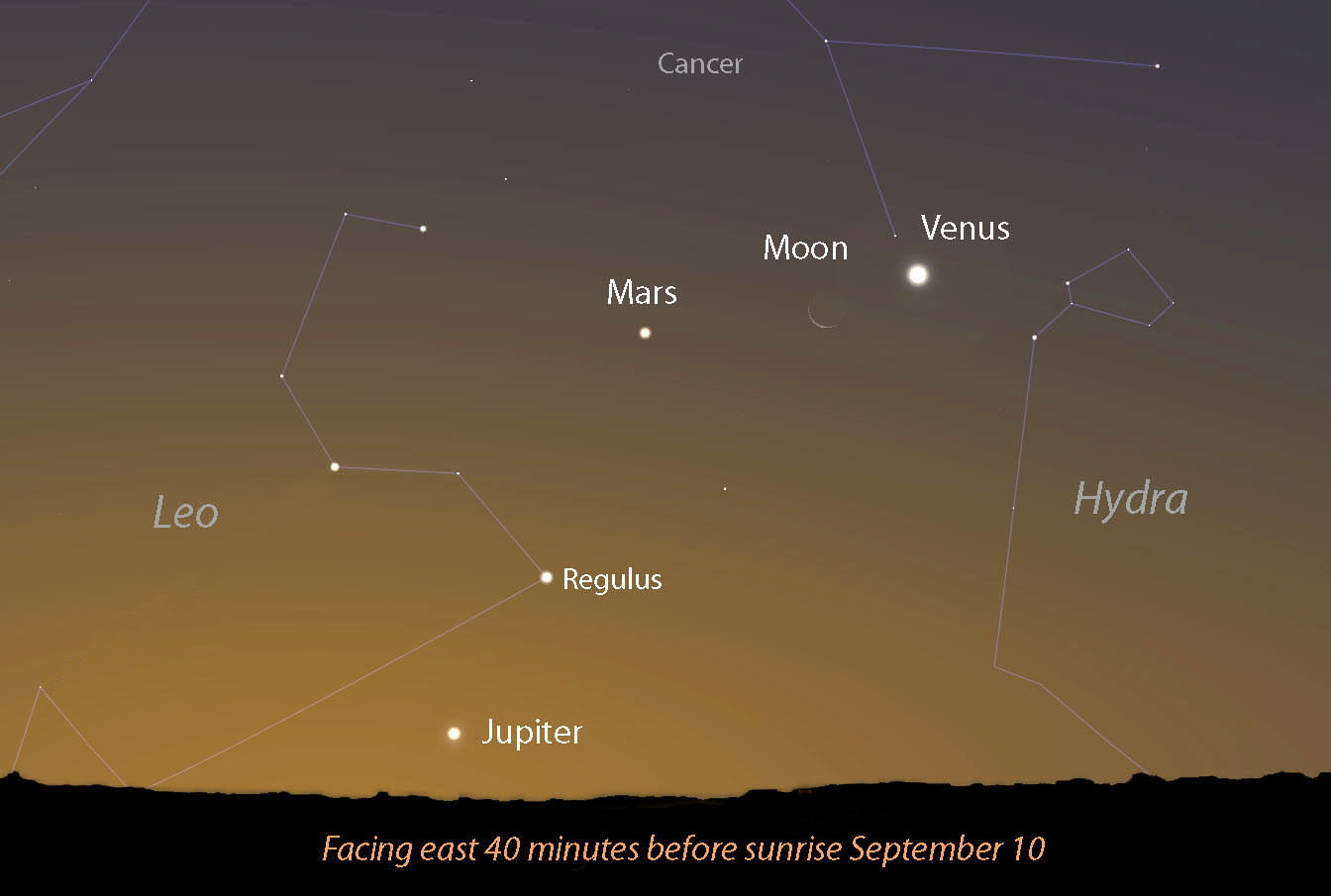
The dawn sky’s where it’s happening. With Saturn swiftly sinking westward at dusk, bright planets have become scarce in the evening hours. But if you get up early and look east, you’ll discover where the party is. Venus, Mars and now Jupiter have the dance floor.
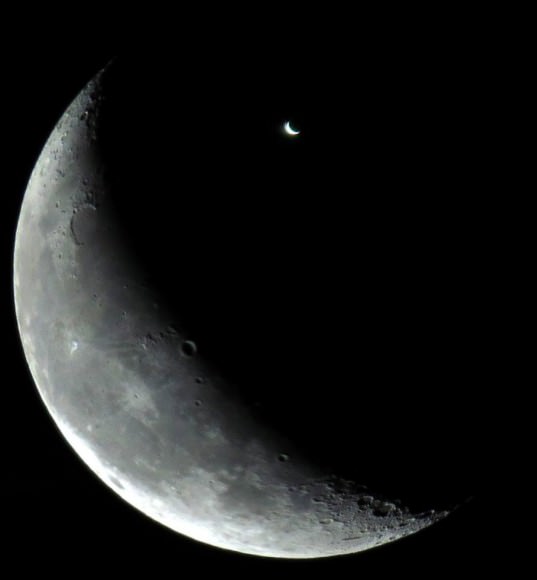
What’s more, the sky gods have seen fit to roll a thin crescent Moon alongside Venus Thursday morning (Sept. 10). This lovely twinning of crescents is best seen about 75 minutes to an hour before sunrise. All you need is a pair of 10x binoculars to see the peewee Venusian version. Its waning crescent phase closely mimics the Moon’s.
From the U.S., the separation between the two will vary from 3° for the East Coast to 4.5° for the West. European and African skywatchers will witness the actual conjunction with the Moon gliding 2.5° north of the planet.
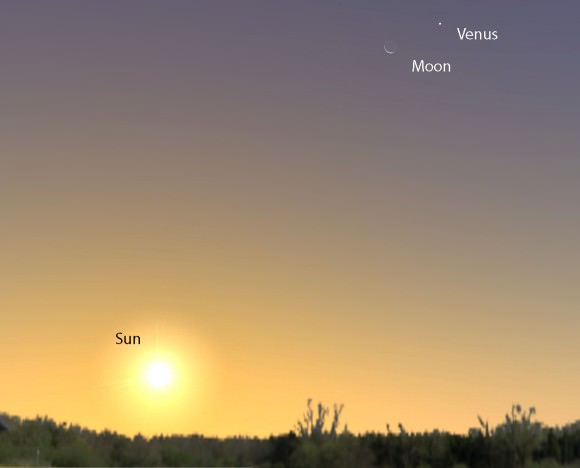
Much fainter Mars, checking in at magnitude +1.8, lies 6° to the left or east of the Moon. It thrills me to see Mars begin a new apparition with its return to the morning sky. Next year, the Red Planet reaches opposition on May 22 in the constellation Scorpius, when it will be brighter than Sirius and more than 18 arc seconds across, its biggest and closest since 2005.
Remember Jupiter? We lost it in the solar glare more than a month ago, but if you can find a location with a nice, open eastern horizon, you can welcome the ever-jovial planet back Thursday. Bring binoculars just in case! Jove’s only a few degrees high in moderately-bright twilight.
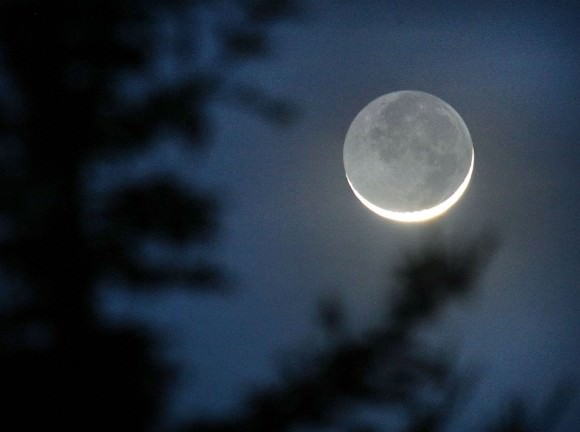
When you look at the Moon Thursday, most of it will be illuminated not by sunlight but by Earth-light called earthshine. This smoky, dark glow results from sunlight bouncing off the globe into space to softly light the otherwise shadowed portion of the Moon. The effect is most pleasing to the eye and remarkable in binoculars, which reveal lunar seas and even larger craters shrouded in blue-dark. Don’t miss it!
Venus and Jupiter Meet At Last
The year’s finest conjunction is upon us. Chances are you’ve been watching Venus and Jupiter at dusk for some time.
Like two lovers in a long courtship, they’ve been slowly approaching one another for the past several months and will finally reach their minimum separation of just over 1/4° (half a Full Moon diameter) Tuesday evening June 30.

Most of us thrill to see a single bright planet let alone the two brightest so close together. That’s what makes this a very special conjunction. Conjunctions are actually fairly common with a dozen or more planet-to-planet events a year and 7 or 8 Moon-planet match-ups a month. It’s easy to see why.
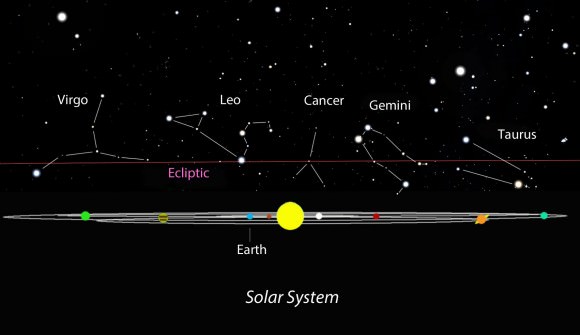
All eight planets travel the same celestial highway around the sky called the ecliptic but at different rates depending upon their distance from the Sun. Distant Saturn and Neptune travel more slowly than closer-in planets like Mercury and Mars. Over time, we see them lap one another in the sky, pairing up for a week or so and inspiring the gaze of those lucky enough to look up. After these brief trysts, the worlds part ways and move on to future engagements.
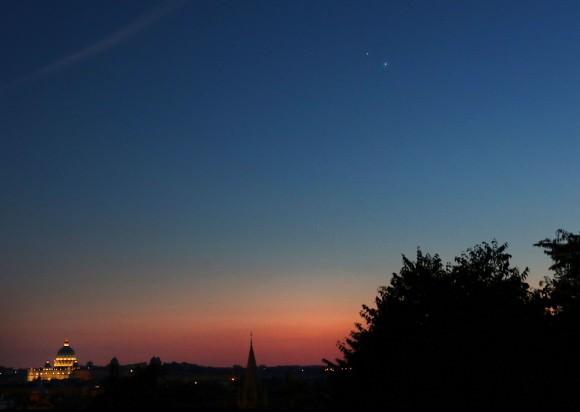
In many conjunctions, the planets or the Moon and planet are relatively far apart. They may catch the eye but aren’t exactly jaw-dropping events. The most striking conjunctions involve close pairings of the brightest planets. Occasionally, the Moon joins the fray, intensifying the beauty of the scene even more.
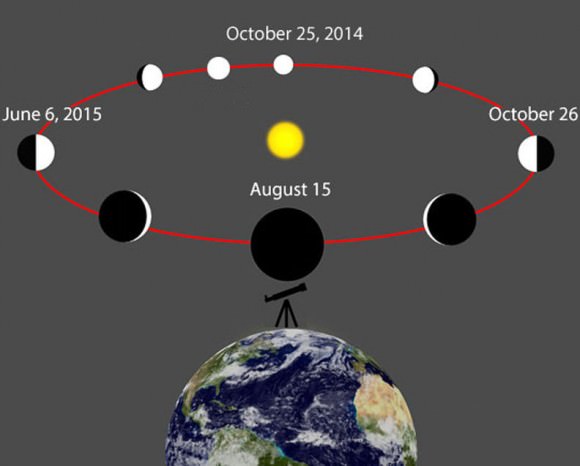
While moving planets are behind many conjunctions, they often don’t do it alone. Earth’s orbital motion around the Sun helps move things along. This week’s event is a perfect example. Venus is currently moving away from Jupiter in the sky but not quickly enough to avoid the encounter. Each night, its apparent distance from the Sun decreases by small increments and the planet loses altitude. Meanwhile, Jupiter’s moving away from Venus, traveling east toward Regulus as it orbits around the Sun.
So how can they possibly get together? Earth to the rescue! Every day, our planet travels some 1.6 million miles in our orbit, completing 584 million miles in one year. We see this movement reflected in the rising and setting times of the stars and planets.
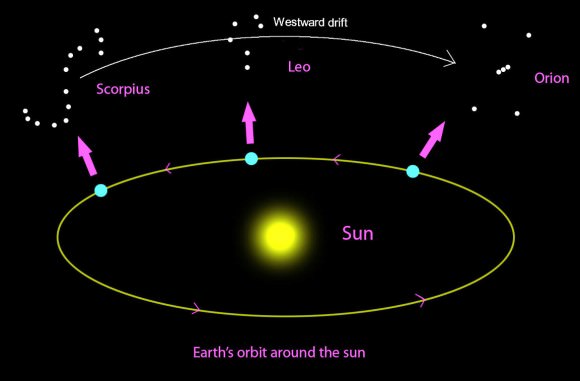
Every night, the stars rise four minutes earlier than the night before. Over days and weeks, the minutes accumulate into hours. When stars rise earlier in the east, those in the west set earlier. In time, all stars and planets drift westward due to Earth’s revolution around the Sun.
It’s this seasonal drift that “pushes” Jupiter westward to eventually overtake a reluctant Venus. Despite appearances, in this particular conjunction, both planets are really fleeing one another!
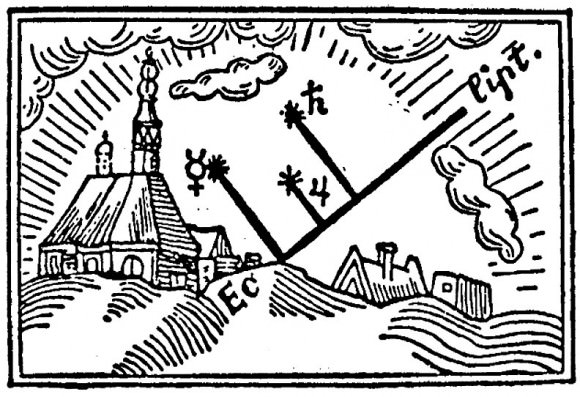
We’re attuned to unusual planetary groupings just as our ancestors were. While they might have seen a planetary alignment as a portent of kingly succession or ill fortune in battle, we’re free to appreciate them for their sheer beauty. Not to say that some might still read a message or experience a personal revelation at the sight. There’s something in us that sees special meaning in celestial alignments. We’re good at sensing change in our environment, so we sit up and take notice when unusual sky events occur like eclipses, bright comets and close pairings of the Moon and planets.

You can watch the Jupiter-Venus conjunction several different ways. Naked eye of course is easiest. Just face west starting about an hour after sunset and drink it in. My mom, who’s almost 90, will be watching from her front step. Binoculars will add extra brilliance to the sight and perhaps show several moons of Jupiter.
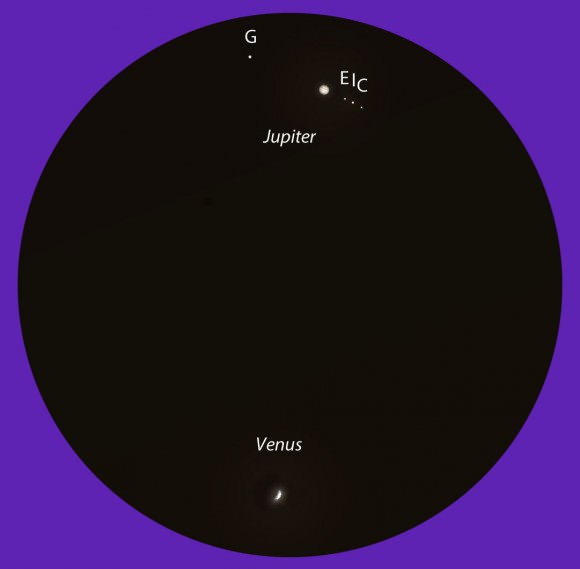
If you have a telescope, I encourage you to point it at the planetary doublet. Even a small scope will let you see Jupiter’s two dark, horizontal stripes — the North and South Equatorial Belts — and several moons. Venus will appear as a pure white, thick crescent 32 arc seconds across virtually identical in apparent size to Jupiter. To tame Venus’ glare, start observing early when the sky is still flush with pale blue twilight. I think the best part will be seeing both planets in the same field of view even at moderate magnification — a rare sight!
To capture an image of these shiny baubles try using your cellphone. For many, that’s the only camera we have. First, find a pretty scene to frame the pair. Hold your phone rock-solid steady against a post or building and click away starting about an hour after sundown when the two planets have good contrast with the sky, but with light still about. If your pictures appear too dark or light, manually adjust the exposure. Here’s a youtube video on how to do it with an iPhone.
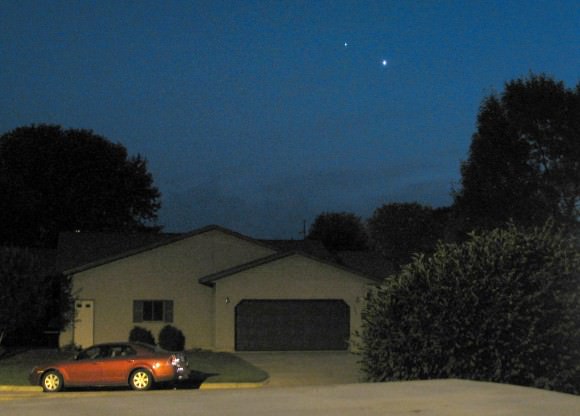
Point-and-shoot camera owners should place their camera on a tripod, adjust the ISO or sensitivity to 100, open the aperture or f/stop to its widest setting (f/2.8 or f/4), autofocus on the planets and expose from 5-10 seconds in mid-twilight or about 1 hour to 90 minutes after sunset. The low ISO is necessary to keep the images from turning grainy. High-end digital SLR cameras have no such limitations and can be used at ISO 1600 or higher. As always, review the back screen to make sure you’re exposing properly.
I’m not a harmonic convergence kind of guy, but I believe this week’s grand conjunction, visible from so many places on Earth, will stir a few souls and help us appreciate this life that much more.

